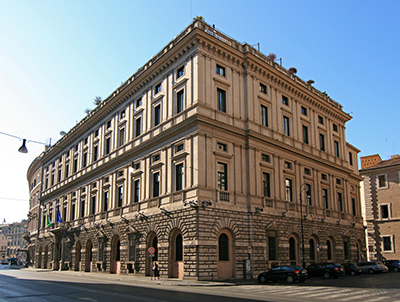Standing majestically at the city centre of Rome, Palazzo Vidoni Caffarelli cuts the picture of a 16th-century renaissance architecture built between the years 1515 and 1536.
Originally, it was built for Bernadino Caffarelli, who came from one of the most prominent and wealthy families in Sant Eustachio at the time. This magnificent building in Corso Vittorio Emanuele II has a façade with seven bays while its ground floor features a rustic foundation. The base features dark tuff which runs horizontally to give the building a classical renaissance look. Currently, the Palazzo Vidoni Caffarelli is a state property hosting the Ministry of Public Administration. It used to be the private residence of cardinal Vidoni. Vidoni enlarged this building to match his preferences before the building became property of Giustiniani Bandini. The building was later to become home to the German embassy where it served that particular purpose for the better part of the 20th century.
Palazzo Vidoni Caffarelli features a covered exterior gallery with a corridor which cements Rome as the second Renaissance capital after Florence. This piece of architecture also has rusticated blocks that decorate its grand entrance. Through the years, Palazzo Vidoni Caffarelli has undergone structural modifications with the most prominent being in 1886. The changes included expansion of the building during the time when the famous Corso Vittorio Emanuelle II was officially opened.
Shortly after the death of Bramante-Raphael's mentor - Pope Leo made Raphael an overseer of all the antiquities in Rome. During that time, the pope had orchestrated the redesign of ancient Rome, and as a result, several thoroughfares had been created. Raphael was made in charge of the designs of palaces that were to decorate the new Roman streets. T was during this time that the Palazzo Vidoni Caffarelli was designed and built. Artist Lorenzo Lotti is said to have made significant contributions towards the building of this palace.
Coming from the neighbouring city of Florence, Lorenzo had had the experience of the art-rich Florence when he finally came to Rome to be a student of Raphael. In an effort to expedite completion of this palace, Raphael appointed his mentee, Lorenzo to complete the building. Another notable assistant of Raphael who helped him with the decoration of the Palazzo Vidoni Caffarelli was Giulio Romano. At a fairly young age, Romano had proven he was indeed talented. Raphael had a total student number of 50 in his workshop, but Romano had found favour with the popular renaissance artist. Even after the death of Raphael in 1520, Giulio Romano continued with the remaining work including the decorating the Villa Farnesina ceiling. He also helped to complete the frescoes of the life of Constantine.




